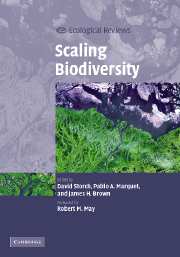Book contents
- Frontmatter
- Contents
- List of contributors
- Foreword by Robert M. May (Lord May of Oxford)
- Preface
- 1 Introduction: scaling biodiversity – what is the problem?
- PART I Spatial scaling of species richness and distribution
- PART II Alternative measures of biodiversity: taxonomy, phylogeny, and turnover
- PART III Scaling of biological diversity with energy and the latitudinal biodiversity gradient
- PART IV Processes, perspectives, and syntheses
- Index
- Plate section
- References
1 - Introduction: scaling biodiversity – what is the problem?
Published online by Cambridge University Press: 05 August 2012
- Frontmatter
- Contents
- List of contributors
- Foreword by Robert M. May (Lord May of Oxford)
- Preface
- 1 Introduction: scaling biodiversity – what is the problem?
- PART I Spatial scaling of species richness and distribution
- PART II Alternative measures of biodiversity: taxonomy, phylogeny, and turnover
- PART III Scaling of biological diversity with energy and the latitudinal biodiversity gradient
- PART IV Processes, perspectives, and syntheses
- Index
- Plate section
- References
Summary
Biological diversity is the most fascinating phenomenon on the Earth. Biologists, amazed by the splendid variety of life, spent several centuries collecting, describing, and classifying living things. We are still engaged in this endeavor. Some groups, such as birds, mammals, molluscs, and vascular plants, have received most of the attention, while others, such as mites, nematodes, fungi, and prokaryotes, remain very poorly known. Moreover, we are still only beginning to understand in depth the processes that generate and maintain the global biodiversity. Part of our ignorance comes from the complexity of observed biodiversity patterns and of the processes that have produced them. These range from evolutionary events that occurred millions of years ago to contemporary interactions between individual organisms and their environments, from biogeographic processes that play out on the scale of continents and oceans to local interactions that can occur on miniscule spatial scales. Part is simply due to the fact that the diversity of life is determined by a multitude of processes which are unique for each taxon and each environment: each kind of organism has unique features of structure and function, which are due to evolutionary constraints and which affect its strategies for survival and reproduction, each type of habitat has its unique abiotic conditions and biotic composition and its own dynamics, and each land mass and body of water has its own geological, climatic, and organic history. Searching for universal laws might seem to be a hopeless task.
- Type
- Chapter
- Information
- Scaling Biodiversity , pp. 1 - 12Publisher: Cambridge University PressPrint publication year: 2007
References
- 3
- Cited by



